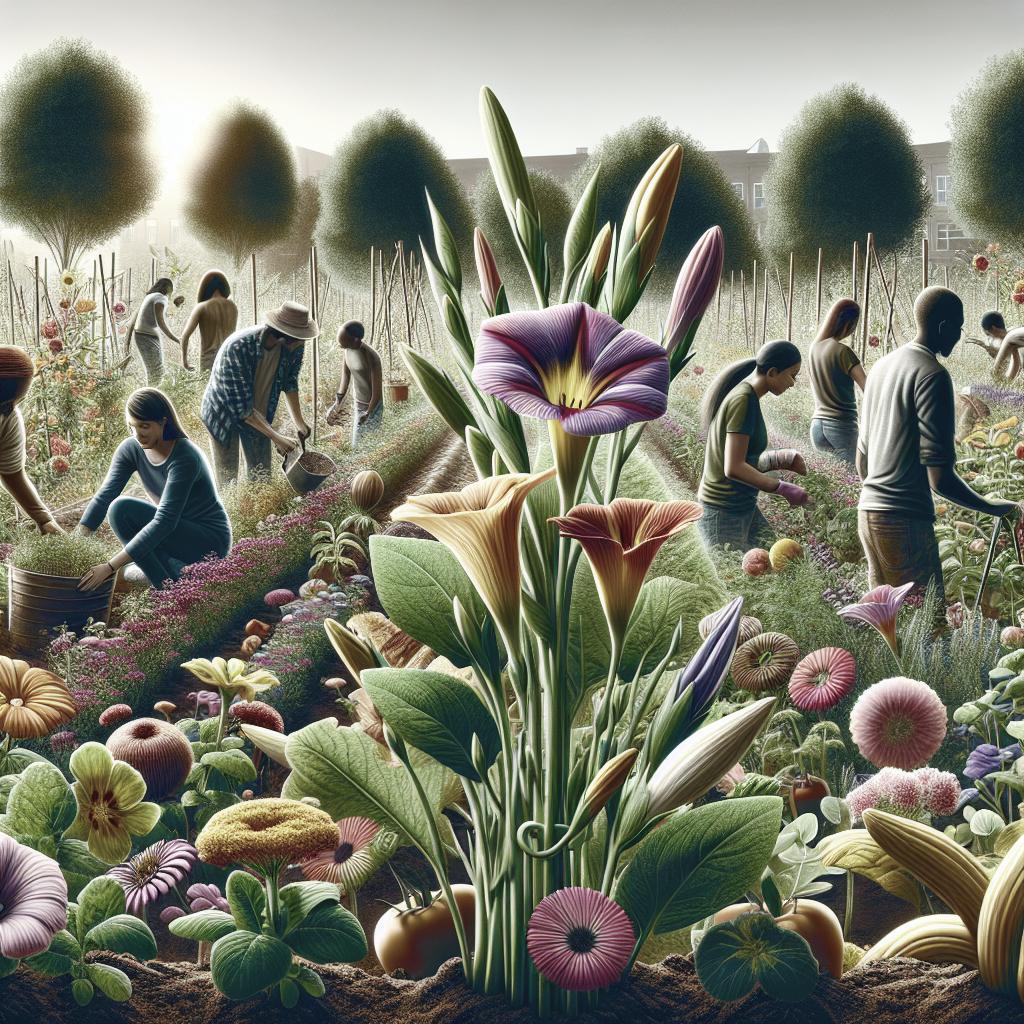Edible flowers are a delightful addition to any garden, transforming it into a vibrant, multi-functional space. Not only do they add a splash of color and beauty, but they also offer unique flavors, textures, and nutritional benefits. This blog post aims to guide community gardeners through the journey of selecting, growing, and utilizing some popular edible flowers, such as Cilantro, Chives, Nasturtium, Thyme, and Violets. We’ll explore each flower’s unique characteristics, cultivation requirements, and culinary uses, so your garden can flourish both aesthetically and gastronomically. Dive in to discover how these flowers can enhance community gardening and help foster a sense of camaraderie and local pride.
Getting to Know Edible Flowers
Edible flowers have been used in culinary arts for centuries, adding color, flavor, and a touch of elegance to dishes. These blooms aren’t just beautiful; they are also packed with nutritional benefits. For community gardeners, incorporating edible flowers can turn a gardening project into a shared culinary adventure, boosting participation and interest. Growing edible flowers in a community garden offers multiple benefits. They attract pollinators, which are essential for the growth of vegetables and fruits, and can be used as companion plants to deter pests organically. Moreover, they provide an excellent opportunity for community education, teaching fellow gardeners and visitors about sustainable growing practices and the benefits of plant diversity.
Edible Flower Favorites
When selecting edible flowers for your community garden, it’s vital to opt for those that are both tasty and easy to grow. Some well-loved options include Cilantro, Chives, Nasturtium, Thyme, and Violets. These flowers offer a range of visual and culinary attractions, making them ideal for community garden projects. Choosing flowers that are easy to maintain ensures consistent harvests and lessens the burden on community members who may have varying experience levels with gardening. The flowers covered in this post are resilient and versatile, suitable for different climates and soil types, making them perfect candidates for community gardening.
Cilantro (Coriandrum sativum)
Often known primarily for its leaves, Cilantro also produces delicate white or pale pink blossoms that are edible. These flowers have a milder taste compared to the leaves but still carry the distinctive cilantro flavor. They are perfect for adding a subtle citrusy note to salads, salsas, and marinades. Cilantro thrives in cool weather and well-drained soil. It’s an excellent plant for community gardens because it’s quick to bolt, which means it will produce flowers rapidly, especially in warmer weather. Once the flowers bloom, the plant will also yield coriander seeds, offering another dynamic ingredient for the garden’s kitchen repertoire.
Chives (Allium schoenoprasum)
Chives produce beautiful purple pom-pom-like blossoms that add a mild onion flavor to dishes. These flowers are not only a vibrant addition to a garden but also attract beneficial insects, including bees and butterflies, which can help improve pollination rates for other plants in the garden. Growing chives is relatively straightforward. They prefer a sunny location and well-drained soil. These perennial plants can return year after year, making them a low-maintenance choice for community gardens. Chives can be harvested by cutting them close to the soil line, and the flowers can be used in soups, salads, and even savory baked goods.
Nasturtium (Tropaeolum majus)
Nasturtiums are a favorite in many community gardens for their bright, cheerful flowers that range from yellow to deep red. The peppery taste of nasturtium flowers makes them a unique and tasty addition to salads, while the leaves can also be used similarly to herbs. These flowers are easy to grow, thriving in poor to average soil and requiring minimal care once established. Nasturtiums are excellent companion plants, as they can deter pests like aphids. They also act as a “trap crop,” luring pests away from more valuable plants. Their vibrant blossoms can be picked continuously from early summer till fall, ensuring a steady supply of edible decorations.
Thyme (Thymus spp.)
Thyme’s tiny, aromatic flowers are as useful as the leaves. The flowers often appear in hues of light purple, with a subtle floral yet earthy flavor. They are an excellent garnish for various dishes, including meats, soups, and stews. Thyme is a perennial herb that requires a sunny location and well-drained soil. It’s quite drought-tolerant, making it a practical addition for community gardens that might not have constant watering schedules. Thyme also has numerous medicinal properties, adding another layer of utility to this versatile plant.
Violets (Viola spp.)
Violets are charming additions to any garden, with their delicate purple, blue, or white blossoms. These blooms have a sweet, slightly floral flavor and can be used to decorate desserts, salads, and even cocktails. They are packed with vitamins A and C and are known for their soothing properties. Growing violets is straightforward, as they prefer cool weather and can thrive in partial shade, making them suitable for various garden locations. They are hardy plants that return each year, creating a perennial burst of color. Violets also work well in container gardens, offering flexibility in garden design.
In Closing
Edible flowers offer a wonderful opportunity to enhance the aesthetic and culinary offerings of a community garden. With selections like Cilantro, Chives, Nasturtium, Thyme, and Violets, gardeners can easily integrate these flowers into their spaces and dishes. Not only do these flowers support biodiversity by attracting pollinators and deterring pests, but they also provide valuable education in sustainable practices and healthy eating. Whether you’re an experienced gardener or a novice, introducing edible flowers into your community garden can foster a sense of community, provide nutritional benefits, and create beautiful, functional spaces that everyone can enjoy.
Share this:
“`html
| Flower | Best Growing Conditions | Culinary Uses | Special Features |
|---|---|---|---|
| Cilantro | Cool weather, well-drained soil | Salads, salsas, marinades | Quick to bolt, produces coriander seeds |
| Chives | Sunny, well-drained soil | Soups, salads, savory baked goods | Attracts beneficial insects |
| Nasturtium | Poor to average soil, minimal care | Salads, herb use | Pest deterrent, trap crop |
| Thyme | Sunny, well-drained soil | Garnish for meats, soups, stews | Medicinal properties, drought-tolerant |
| Violets | Cool weather, partial shade | Desserts, salads, cocktails | Vitamins A and C, soothing properties |
“`


